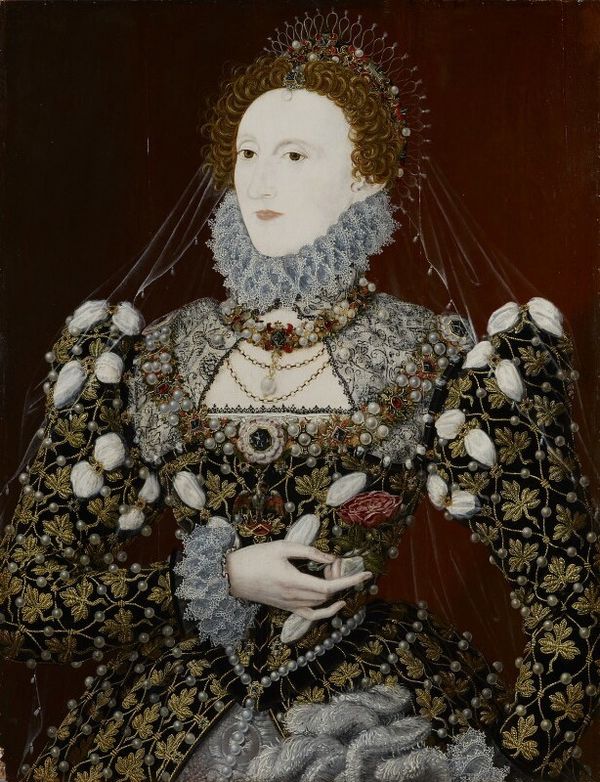
Pearls: Trade, Beauty and North Africa
Pearls were a common symbol of purity and virtue in sixteenth-century English culture and were heavily relied on by Elizabeth I to construct her image as the “Virgin Queen.” Elizabeth’s choice to wear ‘bushels’ of pearls in portraiture and court presentations came at the latter end of the era of pearl popularity (c.1530s-1600s) which resulted in their price increasing ‘by one estimate, sixfold in the first sixty years of the [sixteenth] century’ (Mirabella 2016). Both in her reign and on her person, the pearl was exploited for its rarity, its allusions to chastity and religion, as well as associations with purity and beauty. However, understanding the value of the pearl has been somewhat simplified to only ideals of virginity, partly due to Elizabeth’s prolific use in comparison to other royalty in the period, but also because of a lack of engagement with wider global influences in the early modern period and their impact on the symbolism on even the smallest thing, such as the pearl.
The growing pearl trade and documentation of their sourcing opened early modern England to the ownership of fine and rare materials, but also to the worlds they came from such as Persia, China and Morocco and ways in which they were made. Their variation in colour and size, along with the nature of the pearl found amongst the ‘flesh’ of the clam, contributed to ideas of sexuality, femininity and childbirth with the juxtaposition of the pearl found within but displayed without, which subsequently fed into medical descriptions and descriptors of beauty (Mirabella 2016).
More broadly, pearls represented in popular culture are in some of the intersections between health, beauty, colour and race. Their use in this period by royalty, which had not been done to the same extent by previous medieval monarchs, shows how in this period they became a valuable tool in conveying a message of dynastic right, purity and a place on the global stage. When Romeo first saw Juliet, one of his descriptions compared her to a ‘rich jewel in an Ethiop’s ear’ (Act 1 Scene 5). An enriching sight, her beauty shone more brightly by the contrast of surrounding darkness, a recurrent theme throughout the play and the setting of their next meeting. A racial epithet of beauty, it was not the first or last time Shakespeare evokes Africa and jewellery concerning desire.

Queen Elizabeth I Unknown Artist c. 1588, (c) National Portrait Gallery, London
From Cleopatra to Cressida, Shakespeare frequently used the pearl in relation to exoticised characters to reinforce their physical contrast to his society’s ideals of beauty (pearlescent/clear pale skin) and thereby reaffirm their ties to their non-European roots. One of the most interesting cases of this is how the pearl is used to insult Aaron, the Moor, in Titus Andronicus (1594). Rather than the more typical use of a direct metaphor for beauty, Lucius describes Aaron as both the ‘pearl that pleased the empress eye’ and a ‘wall-eyed slave’ (Act 5 Scene 1) invoking the duality of the pearl in the early modern context. Alongside the literal idea of a pearl as a jewel, it also held associations with conditions of the eye and cataracts which according to humoral theory ‘rendered the patient unable to distinguish anything but light and darkness’ (Iyengar 2014). Therefore, the implication was that Aaron had blinded Tamora with his charismatic villainy causing a lapse in her faculties as Empress of Rome, and obscuring, under pearly gaze, both his dark skin and his villainous character.
It may seem unnecessary to dwell on such small slurs in the grander scheme of Titus Andronicus, which now to modern readers bears little relevance to North Africa. However, the play’s conception and first performances in the 1590s came at a pivotal moment of interaction between the kingdoms of North Africa and England. In this period, England began to look beyond Catholic Europe for ties of friendship and trade in establishing itself as a separate Protestant nation. It turned very much to North Africa, particularly Morocco, which shared a rivalry with Spain. This time of diplomacy and negotiation, which led to a Moroccan diplomatic visit in 1600 that also inspired Shakespeare and his contemporaries, came within a longer history of North African pearls penetrating English culture. Pearls arrived in England in the fourteenth and fifteenth centuries through the ports of North Africa (Carter 2005), and direct trade with these ports also began following newfound shared interests in the mid-sixteenth century. Following Henry VIII's (r. 1509-1547) break with the Roman Pope in the 1530s, Henry kicked off the "Pearl Age" in England since it was imperative for England and the survival of the Tudor dynasty to cultivate relations and trade beyond Catholic Europe. Rather than clump these new relationships under the umbrella of the Middle East or Orient, it is beneficial to pinpoint the detailed use of pearls in this case to gain a nuanced idea of the final decades of the sixteenth century.

Queen Elizabeth I associated with Nicholas Hilliard c. 1575, (c) National Portrait Gallery, London
The idea of pearls as an ‘oriental’ or eastern prop on the early modern stage has shrouded the links of trade and geographical importance of North Africa in early modern drama. By specifying the ties England had to North Africa within this decade, Shakespeare was formulating and writing plays, including Titus Andronicus, to speak to a wider dramatic culture of North African characters and a specific geographical and political association to Morocco, in particular. For instance, dramatist George Peele used the pearl, both in language and prop, to emphasise North African ties in his 1578 play The Battle of Alcazar (Niayesh 2009). The use of pearls in slurs against the raciality of Aaron further highlights old and new relations with North Africa. Additionally, Tamora and Aaron's relationship, as a key plot strand in Titus Andronicus, is emblematic of a growing specific interest in North Africa, both dramatically and socially in 1590s England.

